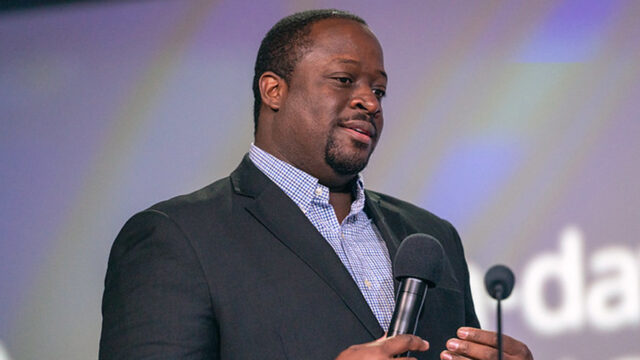How should we relate?

It wasn’t so long ago that the phrase “conspiracy theory” was one you’d hear only irregularly, if at all. Today it seems nearly everyone—from news anchors to your neighbor—is talking about conspiracy theories of various stripes and types. Even more concerning is the weaponization of the phrase—the charge that “they” (whoever “they” may be) are advocating for or otherwise advancing a “conspiracy theory.” I believe these trends of both the mainstreaming and the weaponization of conspiracy theories should be concerning to Seventh-day Adventists.
Two decades ago I preached a sermon called “Jesus and Conspiracy Theories.” I’d had one too many DVDs (this was pre-YouTube) exposing some dark conspiracy pressed urgently into my hand by a well-meaning saint. So, as a preacher, I did what I could: I wrote a sermon about it. Even as a new Christian, I sensed that a robust biblical faith was incompatible with the various conspiracy theories that were in vogue in the early 2000s. Happily, the sermon was always well received, and it seemed that cooler and wiser heads tended to prevail. But the early 2000s feel a long time ago, given the unrelenting pace of modernity. Since then, conspiracy theories have morphed and multiplied.
CONSPIRACY THEORIES— THEN AND NOW
Today there are conspiracy theories on “the right” and “the left,” and everywhere in between, too! Do you want to summarily dismiss and even discredit someone? Simple. Call them a conspiracy theorist. Voilà. It’s as easy as that.
Not very long ago the main conspiracy theories in circulation were such things as “Who killed John F. Kennedy?”; “Was 9/11 an inside job?”; or “Did NASA fake the moon landing?” Those days feel almost tranquil by current standards. In 2021, there’s seemingly a conspiracy theory to fit every political, social, medical, and financial situation. Conspiracies abound regarding everything from COVID-19 and vaccines to such billionaires as Bill Gates and Jeff Bezos, to geopolitical alliances, to the flat earth, to U.S. presidential elections, to the government controlling the weather, to QAnon, to airplane “chemtrails,” to UFOs, etc.
The Internet has created the ideal climate for the proliferation of conspiracy theories by connecting fringe ideas to people and people to fringe ideas. This has given rise to the phenomenon known as “trutherism.” “Trutherism” is the idea that certain truths are being concealed from the public knowledge by a grand and orchestrated conspiracy theory. Worryingly, this is similar to first-century Gnosticism, which significantly threatened the early church. In both cases, the initiated know what is really going on, while the ignorant masses don’t. This desire to be “in the know” (a phrase belonging to the Gnostic dictionary) has an undeniable and, for some, irresistible allure.
Mainstreamers usually dismiss truthers, and truthers dismiss mainstreamers. But strangely, these categories can easily blur and shift, depending on the subject or situation. Since there are so many conspiracy theories to choose from, almost everyone can find one, or more, such theories that appeal to them. Polarization and partisanship prevail. Ideological and religious tribalism becomes the rule rather than the exception.
JESUS AND CONSPIRACIES
So how should we relate to this as Christians? The answer to this crucial and timely question is found by looking at Jesus. When Jesus was on earth, He too was surrounded by conspiracies. Not just conspiracy theories, but actual conspiracies. I can think of at least four.
1. The Pharisees, scribes, and Sadducees were conspiring together to kill Jesus: The Pharisees, who were religious traditionalists, were the ideological enemies of the Sadducees—the modernists—who were the ruling, priestly class positioned and privileged as such by Rome itself. But their mutual hatred of the outsider Jesus brought them together to plot and plan His demise (John 11:45-57; Matt. 12:14; 26:3-5; 27:1, 2).
2. Herod and the Herodians wanted Jesus dead and conspired with the Pharisees to kill Him: Like the Sadducees, the Herodians were unlikely allies of the Pharisees. This Jewish political party favored the rule of King Herod Antipas, the ruler who had John the Baptist beheaded (Matt. 14:1-12). The Herodians are mentioned three times in the Gospels (Matt. 22:16; Mark 3:6; 12:13) and each time they are described as conspiring to trick and trap Jesus. “And the Pharisees went forth, and straightway took counsel with the Herodians against him, how they might destroy him” (Mark 3:6).
3. Judas Iscariot conspired to betray Jesus into the hands of His enemies: Not only were hostile outside forces plotting against Jesus, but one of His own disciples conspired to betray Him to His enemies (cf. Luke 22:4-6) J. B. Phillips’ translation of Luke 22:3 is particularly chilling: “Then a diabolical plan came into the mind of Judas Iscariot, who was one of the twelve.”¹ There it is: “A diabolical plan,” that is, a conspiracy. A member of Jesus’ inner sanctum was conspiring against Him, and Jesus knew it.
4. Behind it all, Satan was conspiring against God’s goodness and government: The conspiracy behind all the other conspiracies was more than human, more than natural. One of God’s own high-ranking angels, Lucifer, had defected and rebelled against God’s goodness and government. This rebellion is reflected in numerous biblical passages (Gen. 3; Isa. 14:12-17; Eze. 28:12-19; Job 1; 2; Matt. 4:1-11; Luke 10:18; John 12:31, 32; Rev. 12). It forms the backdrop for the Great Controversy motif found from Genesis to Revelation. Lucifer’s rebellion constitutes the primary conspiracy that Jesus came to combat and ultimately conquer. I believe this satanic conspiracy against God’s goodness and government is the capital “C” Conspiracy. All other conspiracies—whether real or merely alleged or imagined— are little “c” conspiracies.
HOW DID JESUS RESPOND?
Jesus was acutely aware that nefarious forces were at work to thwart His efforts in fulfilling God’s redemptive plan. How did Jesus relate to these cruel conspiracies? We find an excellent example in Luke 13. Remember, my thesis is that we should follow Jesus’ own example in relating to evil and manipulative conspiracies, both actual and alleged.
This chapter opens with an ominous tone: “There were present at that season some who told Him about the Galileans whose blood Pilate had mingled with their sacrifices” (verse 1). This dark passage seems to suggest that Pontius Pilate, the infamous Roman governor, and no friend of the Jews, had Jewish pilgrims slain while they were in the act of offering their sacrifices in the temple. Apparently, their own blood was mingled with that of their sanctuary sacrifices. This terrible scene would have been utterly discouraging and repulsive to any Jew. Jesus’ referencing it seems to suggest that this was a recent event, perhaps even “breaking news.” The message is clear: it could be unsafe to be a devout Jew in a Roman world.
Following Luke’s ominous opening, a little later in the chapter we come to verse 31: “On that very day some Pharisees came, saying to Him, ‘Get out and depart from here, for Herod wants to kill You.’ ” Though a Jew, Herod wielded the power of Rome as a vassal ruler over Galilee and surrounding regions. Like cruel Pilate in the opening of the chapter, unscrupulous Herod was undoubtedly willing to eliminate political enemies, overly devout Jews, or would-be messiahs. Recall that the king’s father, Herod the Great, had once ordered the destruction of all the Jewish males 2 years old and under in Bethlehem and the surrounding area (Matt. 2:16-18). Clearly Herod and his followers were a force to be reckoned with.
Jesus’ response to the Pharisees’ warning was perfect. It was remarkably brave and profoundly revealing. “He replied, ‘Go tell that fox, “I will keep on driving out demons and healing people today and tomorrow, and on the third day I will reach my goal” ’ ” (Luke 13:32, NIV). Jesus’ flat dismissiveness of the not-so-veiled threat of conspiratorial violence from a ruthless and corrupt government is immensely instructive for us today. He basically says, “So what, I’ve got work to do.” Jesus’ response continues in verse 33: “In any case, I must press on today and tomorrow and the next day” (NIV).
Let’s take a closer look at Jesus’ words. Each phrase, although brief, reveals much about how Jesus related to conspiratorial threats.
“Go tell that fox.” Here Jesus reveals that He is aware of Herod’s reported threats and intents. He is hardly absorbed with the situation, though He understands it. This is an important distinction. Jesus’ use of the image of a fox communicates that He is aware of Herod’s reputation for cleverness and cruelty, but is nevertheless unmoved, as the other key phrases reveal.
“I will reach my goal.” Jesus is marching to a different Drummer. Jesus’ identity and mission transcend Herod’s conspiring just as the sun soars incomprehensibly high above the clouds. Jesus is on a mission, and there is nothing Herod can do to stop Him.
“In any case.” A similar phrase would be “Well, nevertheless” or “Be that as it may.” Jesus’ focused dismissiveness is on full display here. This dismissiveness would not have been lost on the Pharisee messengers, His own disciples, or the ever-thronging crowd, who likely expected Jesus to retreat in fear.
“I must press on.” Jesus is operating on an entirely different level than His enemies. His identity and mission utterly transcend the apparently urgent and dangerous conspiracies swirling around Him.
Let’s return to our earlier question: How should a Christian relate to all this? The short answer, and the best answer, is: What else? As Jesus did.
Jesus understood the difference between conspiracies and the Conspiracy. He kept the big picture big. Was Jesus aware of the conspiracies that surrounded Him? Of course He was. But was He consumed by them? Quite the opposite. As we have noted, He was essentially dismissive of their relative significance when contrasted with His infinitely more important mission and identity.
Jesus’ words in another conversation with the Pharisees offer more insights: “When you lift up the Son of Man, then you will know that I am He, and that I do nothing of Myself; but as My Father taught Me, I speak these things. And He who sent Me is with Me. The Father has not left Me alone, for I always do those things that please Him” (John 8:28, 29). Jesus was on a very specific mission. He lived a life of uninterrupted worship and loyalty—always seeking to “please” His Father. And He is our unfailing example.
WHAT ABOUT US?
Are some of today’s conspiracies real? Undoubtedly. Are others fanciful, speculative, and ultimately untrue? Undoubtedly. Neither of these answers should be surprising to the biblically literate Christian. The world is fallen. Corruption, greed, and injustice are the rule, not the exception. As Paul reminded young Timothy: “But evil men and impostors will grow worse and worse, deceiving and being deceived” (2 Tim. 3:13, NKJV). We live in a time, not unlike most of history, when power—military, financial, societal, institutional—is consolidated in the hands of a few. This being the case, conspiracies and injustice should be expected. We should not be surprised that unconverted and unscrupulous people crave power and control. They will work through any available means—illegal, unethical, or otherwise—to increase their power and control. This is the world we live in. But it’s also the world Jesus came to illumine and save.
Evil is real, but so are righteousness, grace, and mercy. Jesus has established a kingdom on earth built on the immovable foundation of God’s goodness and government. We are called to be earthly citizens of that heavenly kingdom, to be in but not of the world (John 17:11, 14-16).
We are called to resist the allure of the ever-changing and often all-consuming lower “c” conspiracies and remember, as Jesus Himself did, to calibrate our identity and mission according to the capital “C” Conspiracy. Lucifer launched a cruel conspiracy in heaven’s own courts, seeking to malign the loving and just character of God and His government. But God “conspired” to win the war with love.
WRAP-UP
To summarize, here are some simple tips to help you relate to the conspiracy theories you encounter:
1 As a Christian, remember who you are and why you’re here. Keep your God-given identity and mission in sharp focus. Jesus knew who He was and why He was here (cf. Luke 19:10; Matt. 20:28). We should too! Consider that Jesus was so focused and committed to His life’s work that He could say in His early 30s, “I have glorified You on the earth. I have finished the work which You have given Me to do” (John 17:4)!
2 Keep the big picture big. Yes, some conspiracies may be more than just theories, but as Bible believers, we should be focused primarily on the great conspiracy between good and evil. This is the only conspiracy we should be absorbed with.
3 Obsession with unprovable allegations and never-ending speculation can lead one down a rabbit hole that is not easily escaped. Remember the church’s prophetic calling and message. As students of Daniel and Revelation, we are privileged to know what the real issues are and, by extension, what they aren’t. Stay riveted to the three angels’ messages of Revelation 14.
4 Think evangelistically, not combatively. We are not called to win arguments, but to win hearts and souls to the wonder, beauty, and righteousness of God as revealed in His Son, our Savior, Jesus Christ.
I believe Ellen White said it best when she essentially summarized all four of these points in the following statement. This is a good one to ponder, memorize, and share: “In a special sense Seventh-day Adventists have been set in the world as watchmen and light-bearers. To them has been entrusted the last warning for a perishing world. On them is shining wonderful light from the Word of God. They have been given a work of the most solemn import—the proclamation of the first, second, and third angels’ messages. There is no other work of so great importance. They are to allow nothing else to absorb their attention.”²
¹ From J. B. Phillips: The New Testament in Modern English, © J. B. Phillips 1958. Used by permission of Macmillan Publishing Co.
² Ellen G. White, Evangelism (Washington, D.C.: Review and Herald Pub. Assn., 1946), p. 119.








